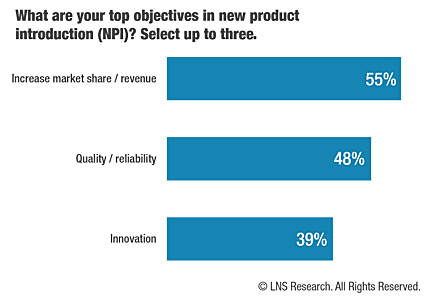Developing high-quality products is more important today than ever before. Market visibility to product quality has never been higher, and competitive pressures continue to squeeze margins and time to market. Manufacturers must consistently deliver better, faster, cheaper. It’s easy to deliver on any one of those adjectives, difficult to accomplish two, but a strategic, collaborative, and digitalized effort is required to consistently achieve all three.
|
ADVERTISEMENT |
How do you measure up against the market? Are you ready to benchmark your organization’s quality contribution to new-product introductions (NPI)?
Quality: A lever to achieve top NPI objectives

Quality teams certainly can’t solve this problem single-handedly, but the quality team holds more of the keys than it might imagine. Early research into this topic by LNS Research reveals that companies’ top three objectives in NPI are increase market share/revenue, quality/reliability, and innovation (n = 185). Obviously, quality plays a major role in the second objective, but it also has a significant impact on the other two.
…

Comments
Concurrent Engineering
After all these many, many years, organizations still persist in siloing, as opposed to concurrent engineering. As the digital thread becomes more and more the state of product development, the silos will, hopefully, erode. But, regardless of the framework, the quality organiztion is key. Only they, truly, are the voice of the customer.
Add new comment